Advantage
Color Beauty of color Color variations
1)Anodized Color Finish
 |
Anodized Color Finish |
When a thin oxide layer (colorless and transparent) is formed on the titanium surface by means of the anodic oxidation method, colors appear due to the interference of light. This method represents a surface finish that produces a wide array of colors expressed by changing the layer thickness. (It is not coated.) |
<Principle of interference color>
Light of specific color is reflected.
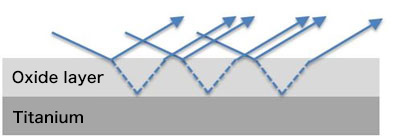
<Image of anodized color titanium>
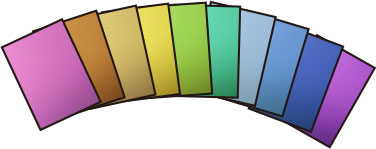
Color can be seen as a result of the interference of light. So,varied facial expressions are shown depending on the curvature of the building, viewing angle, time of day and weather.
<Relationship between layer thickness and interference color (theoretical value)>
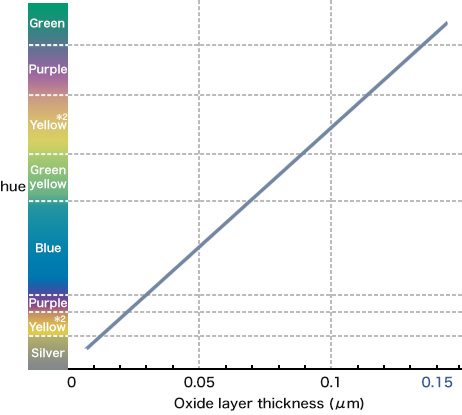
<Precautions for use of anodized color titanium>
It is requested users take note of the following in the use of anodized color titanium:
- Since the oxide layer on the titanium surface is very thin, the color is strongly affected by the substrate surface condition.
When the surface finish differs, the color may look different if the thickness of the oxide layer is the same. Also, if the finish is the same, the delicate difference in color of the substrate peculiar to individual coils will be reflected.
Therefore, NIPPON STEEL conducts the trial color treatment using part of the material that will actually be used for a project before it is put through the coloring process, in addition to the verification of color development with the sample. In addition, when more than one coil are to be used, it is recommended that construction management should be made jointly with the fabricator in a method to minimize color unevenness. - Color may look different depending on the curvature of the building, viewing angle, time of day and weather, due to ”color development of metal” with the interference of light.
Some colors may look totally different on a rainy day. This is a characteristic feature of interference color. Conversely, it would be fun to enjoy the change in colors. - Titanium is stained in the same way as other metals. Fingerprints are left on the surface.
It may sometimes appear that discoloration has taken place due to staining,
but it can be removed with a cleaner; removal can be more difficult when it is left unclean.
It is recommended to use a neutral detergent or a detergent recommended by NIPPON STEEL for cleaning. A cleaning agent containing a strong acid tends to dissolve the oxide film on the surface, and the original color could not possibly be restored.
<Manufacturing method>
The oxide layer on the surface is made to grow by applying a voltage to the anode consisting of titanium in an acidic solution.
The thickness of oxide layer is changed by adjusting the voltage applied to the titanium anode to control the color.
<Image of the anode oxidation method>
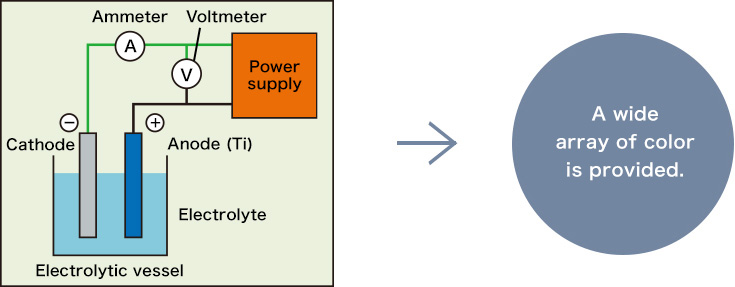
2)IP Gold Titanium
 |
IP Gold Titanium |
This represents a surface finish to impart shine more glossy than “gold” and with superior durability. The bright golden color derives from the inherent material color of titanium nitride, instead of color development by light interference. This represents a surface finish superior in maintenance performance as well surface owing to the titanium nitride layer adhered strongly to the titanium substrate. It can be used outdoors. |
<Manufacturing method>
Titanium nitride layer with a golden color is formed on the surface of titanium sheet under a vacuum by the ion plating method.
<Image of the ion plating method>
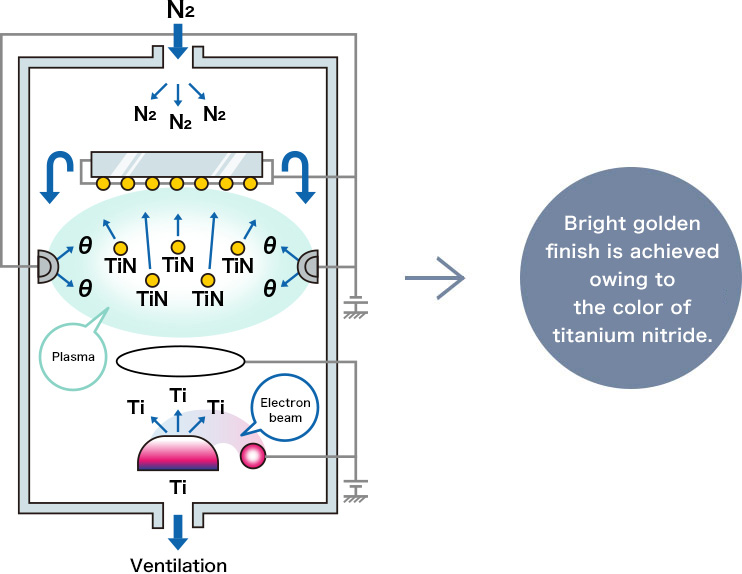
Related Links
Texrure Color beauty Color variations
1)Roll-dull Finish
 |
Roll-dull Finish |
The surface finish is applied to reduce the gloss of the metal. In the field of architecture, it is used in the majority of projects due to its glare-proof property. |
<Manufacturing method>
The texture of the roll surface is transferred to reduce reflection of light on the surface.

2)Blasted Finish
 |
Blasted Finish |
The surface finish is the muted matt surface finish. This product, with the appearance of a “smoked roofing tile”, has been used in Japanese architecture including shrines and temples. It is also possible to intentionally produce roofing tiles with non-uniform baking patterns by changing the blasting conditions. |
<Manufacturing method>
Certain media are irradiated on the surface to control surface roughness and brightness.

3)HYPERBETA
 |
HYPEABETA Titanium |
This is a surface finish based on the texture of titanium crystal grains. Patterning with various crystal sizes is possible. Coloring by the anodic oxidation method also can be accommodated. |
<Manufacturing method>
Heating of titanium causes a crystal pattern to emerge on the surface.

 Expression of various beauty (Color × Texrure)
Expression of various beauty (Color × Texrure)












